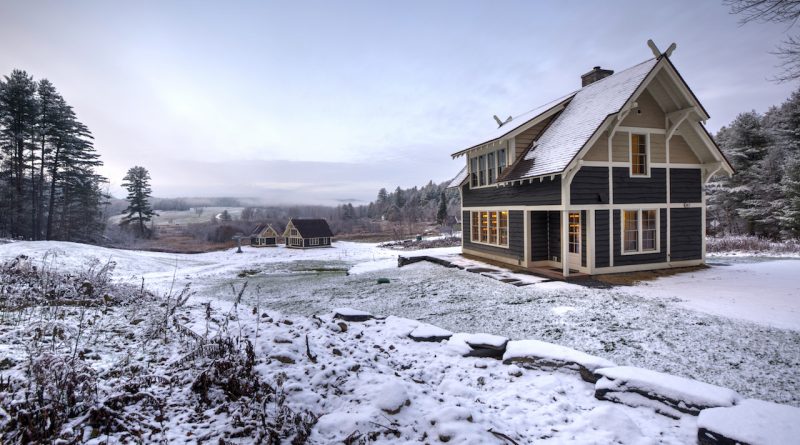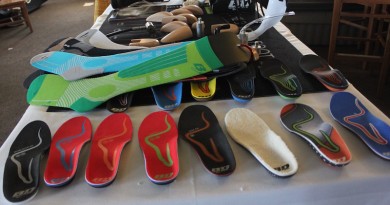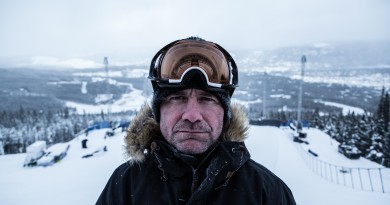How A Defunct Ski Area Became A Home
So you bought an old ski area and want to live there? The old outbuildings of a tiny, defunct ski area get new life as a family home.
Some people create little ski areas behind their homes. They may put in a lift, cut some trails and call it a day. Peter and Karen Dartley did the opposite: They recently bought a defunct ski area, installed a T-bar and began renovating a cluster of old lift and lodge buildings, one of which will serve as a weekend home.
Located just north of Rutland, in the hamlet of Hubbardton, High Pond Ski Area dates back to the 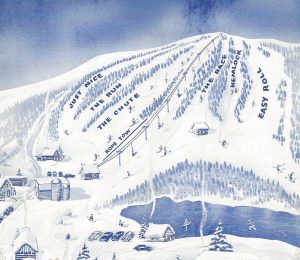 1940s. For more than 50 years, the tiny ski area operated on 40 acres with rope tows and a T-bar that took skiers up to 1,400 feet elevation and gave them a choice of as many as 8 runs for the 300-vertical-foot descent.
1940s. For more than 50 years, the tiny ski area operated on 40 acres with rope tows and a T-bar that took skiers up to 1,400 feet elevation and gave them a choice of as many as 8 runs for the 300-vertical-foot descent.
According to Jeremy Davis, founder of the New England Lost Ski Areas project, the tiny ski hill was founded by W. Douglas Burden, (the developer of Marineland in Miami and in California) as a private hill that he opened to the public occasionally. It had one of the first platter pull lifts in the early 1940s and ’50s, and one of the earliest snowmaking plants. Later, it went through a number of owners, and was often open to the public on weekends. The area has been closed since the early 1980s.
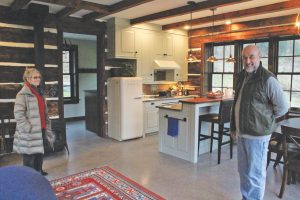
In many ways, Dartley, 71, is following in Burden’s path. He is the former managing director of the now-defunct Pequot Capital Management, Inc., one of the world’s largest hedge funds in the 1990s. He and his wife also operate the Dartley Charitable Trust based in Wilton, Conn., an arts, culture and humanities non-profit that currently holds $4.32 million.
The couple, who live in Manhattan, has been escaping to Vermont for more than 40 years and bought a house in Ludlow in 1981. “When we bought that house, it was a pasture,” Dartley says. “Now, there’s a forest, a three-acre lake, and a windmill. It’s quiet and secluded. We love Vermont. It’s one of our passions.”
They have a five-year plan for the High Pond property, which they hope to develop as a family compound. “I used to ski, but then I had my knee fixed and I don’t anymore,” Peter says. “And I wasn’t a very good skier anyway.” However, their son Christopher is an avid snowboarder and arborist who was looking for a farm. He was the one who found the High Pond property and urged his parents to have a look.
“He has always wanted to have a sustainable, working farm,” Karen says. There is already a small lake called Walker Pond on the property, and Dartley plans to erect solar panels and a windmill, making the property as self-sustainable as possible. Their other son, Alec, is a painter and snowboards as well. So do their five grandchildren.
The couple, who have been married for 48 years, came to see the High Pond property for the first time on the coldest day of the year in February, 2016.
“And that’s the day we decided to buy it,” Karen said. “We fell in love with it.”
A LITTLE HISTORY
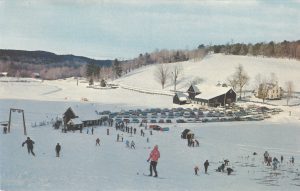
Many people in the area can remember skiing at High Pond as children and still have a soft spot for the old ski hill.
By the 1960s and 70s, there was a small base lodge, a warming hut, a T-bar and three rope tows, a ski shop and snack bar, and parking for 200 cars. According to the 1973 Ski Guide to the Northeast, lift tickets were $5 for adults, and $4 for kids.
The Dartleys inherited old promotional postcards, brochures and patches when they bought the property. The back of the brochure shows a cartoon goose on skis pronouncing, “We’re not the biggest… but one of the best!”
“Every time we’re here, someone stops and wants to talk about the old days,” Dartley said with a smile. “One guy even had a lift ticket from years ago. I told him I’d look the other way and honor it for one lift ride up.”
AUTHENTIC RESTORATION
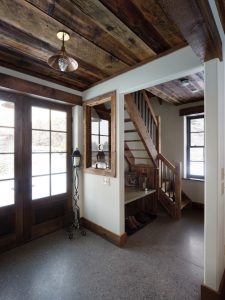
Work began in earnest almost immediately after the couple bought the 330-acre parcel for $1.3 million last year.
The McKernon Group of Brandon, led by Kevin Birchmore, was hired to do the construction, and Selin and Selin Architecture in Shelburne did all of the design work. “We loved the look of the old buildings and wanted to replicate that,” says architect Stephen Selin. The team settled on trying to keep the logs on the inside of the Alpine Restaurant – a 650 square foot building that became a one-bedroom cabin.
The exterior was covered in live-edge siding. Builder Kevin Birchmore of The McKernon Group grew up skiing at High Pond —”I broke my leg there in fifth grade,” he says with a laugh. He worked hard to use as many of the original timbers as possible and to refashion doors and floors to match the distressed look of older wood.
“The whole family is really excited about this,” Dartley said with a smile as he sat in the living area of the restored Terminal building wearing a gray fleece with a High Pond Ski Area patch sewn to the left chest area. His daughter-in-law surprised everyone in the family with fleeces embossed with the old High Pond Ski Area patches.
Dartley will happily sit in the restored building and watch his sons and grandchildren come down the mountain, just like High Pond founder W. Douglass Burden. Legend has it that the wealthy businessman built the ski area so he could watch people ski from his living room window. He was said to have owned 10,000 acres of land in the High Pond area and built a nature museum on his property, which burned to the ground in 1970.
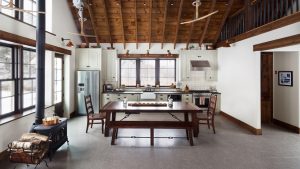
The Dartleys’ goal was to preserve as much of Burden’s original buildings as possible. The Terminal building, the former ski patrol building, the old barn and the Alpine restaurant building had all been sitting vacant for decades. Time took its toll and parts of the barn and other buildings that were too far gone were taken down. But repurposing and rehabilitating old structures is The McKernon Group’s specialty, and a lot of the wood was reused for windowsills, doors, baseboards, and other architectural touches in the Terminal and Alpine buildings.
“It was an incredible project,” says architect Steve Selin. “It’s not easy to pick up and move a log structure [the Alpine] that old but the McKernon team did it.”
The Terminal building will act as a gathering place for the family at the base of the T-bar. It has a kitchen, comfortable seating area and a bathroom. The old ticket window is to the left of the front door, and the old T-bar wheel hangs from the ceiling. Two old wooden T-bars were turned into lighting fixtures and hang 15 feet above the main room.
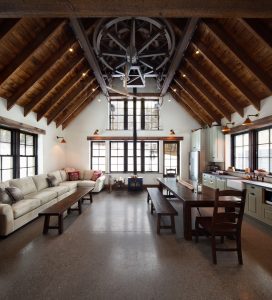
The Alpine building was moved back from the road, gutted, and rebuilt into a beautiful one-bedroom guesthouse with a full kitchen, living area, and two baths. All of the chinking was replaced and the old wallboards were restored to maintain the original look of Burden’s building. “We tried to get it to look the way it looked back in the day,” Dartley says.
A PRIVATE MOUNTAIN
There was a buzz in the skiing community last fall when an online news item appeared with the headline “Defunct High Pond Ski Area Being Rebuilt.” The article was posted on the New England Ski Industry News website.
The article included photos of the new Leitner Poma lift equipment that had been delivered to the old ski hill, and mentioned that the old T-bar equipment had been removed.
Most of the excitement was around speculation that the ski area was going to be restored and re-opened to the public. But Peter Dartley says that was never the plan.
“We have no expertise and no one in the family has an interest in doing that,” he says. “It’s also prohibitively expensive for insurance purposes.”
Also, Dartley says, there is a portion of the property that is designated wetland not far from where the parking would have to be.
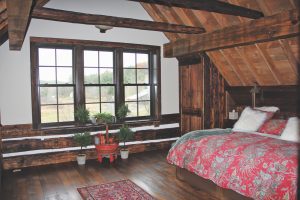
“The state had been very specific about wetland management,” Dartley said. “We couldn’t really provide parking.”
But overall, Dartley said, the state was very supportive during the construction process, which also involved dealing with the disposal of wet asbestos from the old buildings, as well as old diesel and oil tanks that had to come out of the ground.
“The state has been phenomenally helpful,” Dartley said.
While the Dartleys would not put a price tag on the restoration, Peter called it “substantial.”
“We could have done this for less if we didn’t want to preserve the original character and nature of the place,” he says.
“We love history,” Karen adds, “and we love projects.”
“Burden did a beautiful job of creating something here and when he sold it, unfortunately, it got really run down,” Peter notes. “We wanted to bring it back to the way it was. It’s something of a legacy project for us.”
Featured photo by Lindsay Selin.

